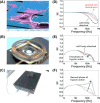Biologically sensitive field-effect transistors: from ISFETs to NanoFETs
- PMID: 27365038
- PMCID: PMC4986460
- DOI: 10.1042/EBC20150009
Biologically sensitive field-effect transistors: from ISFETs to NanoFETs
Abstract
Biologically sensitive field-effect transistors (BioFETs) are one of the most abundant classes of electronic sensors for biomolecular detection. Most of the time these sensors are realized as classical ion-sensitive field-effect transistors (ISFETs) having non-metallized gate dielectrics facing an electrolyte solution. In ISFETs, a semiconductor material is used as the active transducer element covered by a gate dielectric layer which is electronically sensitive to the (bio-)chemical changes that occur on its surface. This review will provide a brief overview of the history of ISFET biosensors with general operation concepts and sensing mechanisms. We also discuss silicon nanowire-based ISFETs (SiNW FETs) as the modern nanoscale version of classical ISFETs, as well as strategies to functionalize them with biologically sensitive layers. We include in our discussion other ISFET types based on nanomaterials such as carbon nanotubes, metal oxides and so on. The latest examples of highly sensitive label-free detection of deoxyribonucleic acid (DNA) molecules using SiNW FETs and single-cell recordings for drug screening and other applications of ISFETs will be highlighted. Finally, we suggest new device platforms and newly developed, miniaturized read-out tools with multichannel potentiometric and impedimetric measurement capabilities for future biomedical applications.
Keywords: field-effect transistors; field-effect-based biosensors; silicon nanowire sensors.
© 2016 The Author(s). Published by Portland Press Limited on behalf of the Biochemical Society.
Figures







Similar articles
-
Ion sensitive field effect transducer-based biosensors.Biotechnol Adv. 2003 Sep;21(6):527-34. doi: 10.1016/s0734-9750(03)00103-4. Biotechnol Adv. 2003. PMID: 14499153 Review.
-
Label-free DNA sensors using ultrasensitive diamond field-effect transistors in solution.Phys Rev E Stat Nonlin Soft Matter Phys. 2006 Oct;74(4 Pt 1):041919. doi: 10.1103/PhysRevE.74.041919. Epub 2006 Oct 27. Phys Rev E Stat Nonlin Soft Matter Phys. 2006. PMID: 17155108
-
Silicon nanowire biologically sensitive field effect transistors: electrical characteristics and applications.J Nanosci Nanotechnol. 2014 Jan;14(1):273-87. doi: 10.1166/jnn.2014.8760. J Nanosci Nanotechnol. 2014. PMID: 24730263 Review.
-
Silicon nanowire field-effect-transistor based biosensors: from sensitive to ultra-sensitive.Biosens Bioelectron. 2014 Oct 15;60:101-11. doi: 10.1016/j.bios.2014.03.057. Epub 2014 Apr 15. Biosens Bioelectron. 2014. PMID: 24787124 Review.
-
Ultra-sensitive nucleic acids detection with electrical nanosensors based on CMOS-compatible silicon nanowire field-effect transistors.Methods. 2013 Oct;63(3):212-8. doi: 10.1016/j.ymeth.2013.07.012. Epub 2013 Jul 22. Methods. 2013. PMID: 23886908
Cited by
-
Recent advances and challenges in electrochemical biosensors for emerging and re-emerging infectious diseases.J Electroanal Chem (Lausanne). 2020 Dec 1;878:114596. doi: 10.1016/j.jelechem.2020.114596. Epub 2020 Aug 25. J Electroanal Chem (Lausanne). 2020. PMID: 32863810 Free PMC article. Review.
-
Novel Nanofluidic Cells Based on Nanowires and Nanotubes for Advanced Chemical and Bio-Sensing Applications.Nanomaterials (Basel). 2021 Jan 3;11(1):90. doi: 10.3390/nano11010090. Nanomaterials (Basel). 2021. PMID: 33401631 Free PMC article. Review.
-
Dual-Channel Detection of Breast Cancer Biomarkers CA15-3 and CEA in Human Serum Using Dialysis-Silicon Nanowire Field Effect Transistor.Int J Nanomedicine. 2022 Dec 13;17:6289-6299. doi: 10.2147/IJN.S391234. eCollection 2022. Int J Nanomedicine. 2022. PMID: 36536938 Free PMC article.
-
An ImmunoFET Coupled with an Immunomagnetic Preconcentration Technique for the Sensitive EIS Detection of HF Biomarkers.Micromachines (Basel). 2024 Feb 21;15(3):296. doi: 10.3390/mi15030296. Micromachines (Basel). 2024. PMID: 38542544 Free PMC article.
-
Top-Down Fabricated Silicon Nanowire Arrays for Field-Effect Detection of Prostate-Specific Antigen.ACS Omega. 2018 Aug 1;3(8):8471-8482. doi: 10.1021/acsomega.8b00990. eCollection 2018 Aug 31. ACS Omega. 2018. PMID: 31458975 Free PMC article.
References
-
- Nishi Y., Doering R. Handbook of Semiconductor Manufacturing Technology. 2nd edn. Boca Raton: CRC Press; 2007.
-
- Besselink G.A.L., Bergveld P. ISFET affinity sensor. In: Rogers K.R., Mulchandani A., editors. Affinity Biosensors: Techniques and Protocols. Totowa: Springer Humana Press; 1998. pp. 173–185.
-
- Sze S.M., Ng K.K. Physics of Semiconductor Devices. 3rd edn. Hoboken: Wiley; 2006.
-
- Thirsk H.R., Rangarajan S.K. The electrical double layer. Electrochemistry. 1980;7:203–256. doi: 10.1039/2050-9413. - DOI
Publication types
MeSH terms
Substances
LinkOut - more resources
Full Text Sources
Other Literature Sources

